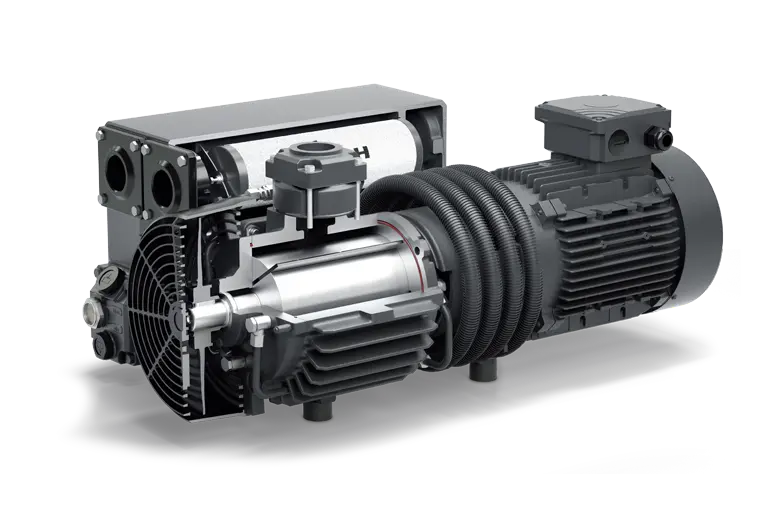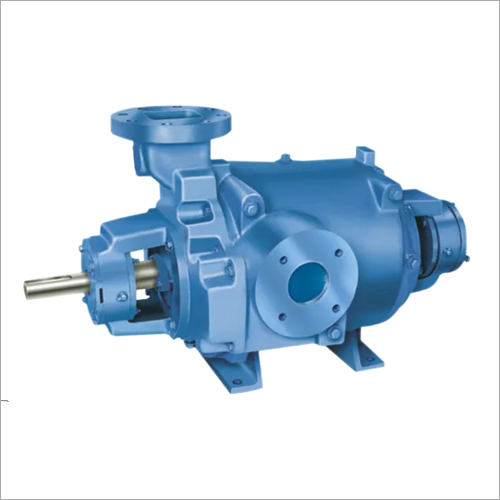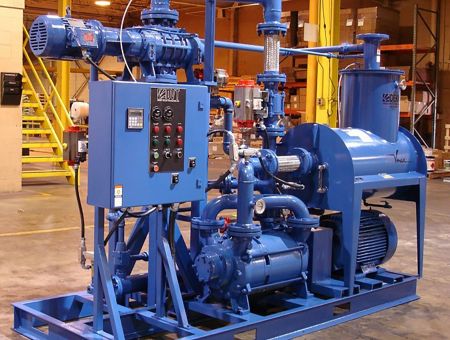Product Description
Product Description
The vacuum pump 30-WS is mainly used in the sealing oil system of steam turbines and generators, with the ability to efficiently handle condensate steam and gas loads. The main function of a vacuum pump in a sealing oil system is to extract gas and air from the system to maintain the vacuum inside the system and ensure the flow and sealing performance of lubricating oil.
Structure:
The vacuum pump 30-WS consists of a pump body, rotor, driving device, exhaust valve, intake valve, and lubrication system. The rotor generates compression and emission of gas through rotational motion. The driving device is used to drive the rotor to rotate. The exhaust valve controls the direction of gas flow, while the intake valve controls gas entry into the pump body.
작동 원리
The working principle of vacuum pump 30-WS is to compress and discharge gas through the rotation of the rotating blades on the rotor. When the rotor rotates, a changing sealing chamber is formed between the rotor and the inner wall of the pump body. Gas is sucked in and gradually compressed, and then discharged from the pump body through the exhaust port.
Commonly used spare parts:
The commonly used spare parts for maintenance of vacuum pumps include the following:
Key, wave spring, spring, screw, rocker seal, front end seat, front axle shell, mechanical seal, bearing components, seal, rear end seat.
Detailed Photos
Product Features:
> Efficiently handle condensate steam and gas loads.
> High vacuum and high volumetric efficiency.
> Widely used in various chemical substances.
> Stable and reliable performance, capable of long-term stable operation.
Applications of Vacuum Pumps:
1. Vacuum distillation, vacuum drying, vacuum concentration, and other processes in the chemical industry.
2. Operations such as vacuum drying and evaporation concentration in the pharmaceutical industry.
3. Applications such as vacuum packaging, vacuum filling, vacuum drying, and vacuum freezing in the food industry.
4. Electronic device manufacturing and packaging process.
5. The fields of semiconductors and solar cells.
Related Products
Yoyik offers different types of Hydraulic pumps for industrial users:
liquid ring vacuum pump working principle ZS-185
double stage vacuum pump price P-1764-1
vacuum pump spare parts Rocker seal 30-SPEN
rotary vacuum pump 2S-185
roots vacuum pump working principle 30-WSRP
vacuum pump bearing 30SPEN
water seal vacuum pump WSRP-30
roots vacuum pump working principle WS-30
high vacuum pump oil ROTARYpump NO.30-WS SEARIAL
vacuum pump spares P-1764-1
liquid ring vacuum pump working principle 2S-185
vacuum booster pump P-1931A
industrial vacuum pump 6205
vacuum pump back seat 2S-185
vacuum pump key ZS-185
two stage liquid ring vacuum pump 30-SPEN
roots vacuum pump working principle 30WS
Packaging & Shipping
Standard & CHINAMFG packaging ensures your goods safety.
Various professional packages at your choice
Multiple choice of reliable and cost-effective shipping methods available.
Company Profile
– ABOUT US –
HangZhou Yoyik Engineering Co., Ltd is located in HangZhou, ZheJiang , China’s heavy equipment base, was founded in 2004. The company is a professional power plant spare parts manufacturer and supplier. Our products are applicable for many thermal power plants, hydropower plants, metallurgic industrial power plant, cement plant power house, aluminum plant power house, and coal mill power plants.
From advanced precision electric elements and components to highly-customized metal items, you can find all the needed for a power plant from Yoyik.
Yoyik is the exclusive agent of W.M. Nugent CO Inc for selling Nugent filter elements and filtration system products in China. The company also has great advantages in of many hydraulic products, including pumps, valves, sealing materials, etc. the brands include Eaton, Vickers, Moog, star, copaltite, temp-tite, 707, etc.
Our Advantages
– TECHNICAL PATENTS –
– OUR ADVANTAGE –
– COOPERATIVE INDUSTRIES –
Yoyik offers wide range of spare parts for customers in different industries:
자주 묻는 질문
– ORDER NOTES –
√ Model Selection
Before purchasing, please ensure that the model specifications you provide are complete or that the drawings have been drawn so that you can provide timely and accurate quotations.
√ Quality Assurance
We promise to provide high-quality products and after-sales service. If there are any quality issues, please contact us promptly.
√ Secure Transactions
We sell on MIC, provide a secure and reliable trading environment, and accept multiple payment methods to facilitate your purchase.
– FAQ –
– Are you trading company or manufacturer?
We are factory located in HangZhou, China.
– How long is your delivery time?
Generally it is 2-5 days if the goods are in stock. Or it is 7-21 days if the goods are not in stock, it is according to quantity.
– Do you provide samples? Is it free or extra?
Sorry we do not offer samples.
– What price terms do you accept?
Our company can accept all trading manners, eg. EXW, FOB, CIF etc
– What payment terms do you accept?
We accept T/T.
| After-sales Service: | Online Support |
|---|---|
| Warranty: | Na |
| Oil or Not: | Oil |
| Structure: | Rotary Vacuum Pump |
| Exhauster Method: | Kinetic Vacuum Pump |
| Vacuum Degree: | High Vacuum |
| Customization: |
Available
|
|
|---|

Can Vacuum Pumps Be Used in the Aerospace Sector?
Vacuum pumps indeed have various applications in the aerospace sector. Here’s a detailed explanation:
Vacuum pumps play a crucial role in several areas of the aerospace industry, supporting various processes and systems. Some of the key applications of vacuum pumps in the aerospace sector include:
1. Space Simulation Chambers: Vacuum pumps are used in space simulation chambers to replicate the low-pressure conditions experienced in outer space. These chambers are utilized for testing and validating the performance and functionality of aerospace components and systems under simulated space conditions. Vacuum pumps create and maintain the necessary vacuum environment within these chambers, allowing engineers and scientists to evaluate the behavior and response of aerospace equipment in space-like conditions.
2. Propellant Management: In space propulsion systems, vacuum pumps are employed for propellant management. They help in the transfer, circulation, and pressurization of propellants, such as liquid rocket fuels or cryogenic fluids, in both launch vehicles and spacecraft. Vacuum pumps assist in creating the required pressure differentials for propellant flow and control, ensuring efficient and reliable operation of propulsion systems.
3. Environmental Control Systems: Vacuum pumps are utilized in the environmental control systems of aircraft and spacecraft. These systems are responsible for maintaining the desired atmospheric conditions, including temperature, humidity, and cabin pressure, to ensure the comfort, safety, and well-being of crew members and passengers. Vacuum pumps are used to regulate and control the cabin pressure, facilitating the circulation of fresh air and maintaining the desired air quality within the aircraft or spacecraft.
4. Satellite Technology: Vacuum pumps find numerous applications in satellite technology. They are used in the fabrication and testing of satellite components, such as sensors, detectors, and electronic devices. Vacuum pumps help create the necessary vacuum conditions for thin film deposition, surface treatment, and testing processes, ensuring the performance and reliability of satellite equipment. Additionally, vacuum pumps are employed in satellite propulsion systems to manage propellants and provide thrust for orbital maneuvers.
5. Avionics and Instrumentation: Vacuum pumps are involved in the production and testing of avionics and instrumentation systems used in aerospace applications. They facilitate processes such as thin film deposition, vacuum encapsulation, and vacuum drying, ensuring the integrity and functionality of electronic components and circuitry. Vacuum pumps are also utilized in vacuum leak testing, where they help create a vacuum environment to detect and locate any leaks in aerospace systems and components.
6. High Altitude Testing: Vacuum pumps are used in high altitude testing facilities to simulate the low-pressure conditions encountered at high altitudes. These testing facilities are employed for evaluating the performance and functionality of aerospace equipment, such as engines, materials, and structures, under simulated high altitude conditions. Vacuum pumps create and control the required low-pressure environment, allowing engineers and researchers to assess the behavior and response of aerospace systems in high altitude scenarios.
7. Rocket Engine Testing: Vacuum pumps are crucial in rocket engine testing facilities. They are utilized to evacuate and maintain the vacuum conditions in engine test chambers or nozzles during rocket engine testing. By creating a vacuum environment, these pumps simulate the conditions experienced by rocket engines in the vacuum of space, enabling accurate testing and evaluation of engine performance, thrust levels, and efficiency.
It’s important to note that aerospace applications often require specialized vacuum pumps capable of meeting stringent requirements, such as high reliability, low outgassing, compatibility with propellants or cryogenic fluids, and resistance to extreme temperatures and pressures.
In summary, vacuum pumps are extensively used in the aerospace sector for a wide range of applications, including space simulation chambers, propellant management, environmental control systems, satellite technology, avionics and instrumentation, high altitude testing, and rocket engine testing. They contribute to the development, testing, and operation of aerospace equipment, ensuring optimal performance, reliability, and safety.

How Do Vacuum Pumps Affect the Performance of Vacuum Chambers?
When it comes to the performance of vacuum chambers, vacuum pumps play a critical role. Here’s a detailed explanation:
Vacuum chambers are enclosed spaces designed to create and maintain a low-pressure environment. They are used in various industries and scientific applications, such as manufacturing, research, and material processing. Vacuum pumps are used to evacuate air and other gases from the chamber, creating a vacuum or low-pressure condition. The performance of vacuum chambers is directly influenced by the characteristics and operation of the vacuum pumps used.
Here are some key ways in which vacuum pumps affect the performance of vacuum chambers:
1. Achieving and Maintaining Vacuum Levels: The primary function of vacuum pumps is to create and maintain the desired vacuum level within the chamber. Vacuum pumps remove air and other gases, reducing the pressure inside the chamber. The efficiency and capacity of the vacuum pump determine how quickly the desired vacuum level is achieved and how well it is maintained. High-performance vacuum pumps can rapidly evacuate the chamber and maintain the desired vacuum level even when there are gas leaks or continuous gas production within the chamber.
2. Pumping Speed: The pumping speed of a vacuum pump refers to the volume of gas it can remove from the chamber per unit of time. The pumping speed affects the rate at which the chamber can be evacuated and the time required to achieve the desired vacuum level. A higher pumping speed allows for faster evacuation and shorter cycle times, improving the overall efficiency of the vacuum chamber.
3. Ultimate Vacuum Level: The ultimate vacuum level is the lowest pressure that can be achieved in the chamber. It depends on the design and performance of the vacuum pump. Higher-quality vacuum pumps can achieve lower ultimate vacuum levels, which are important for applications requiring higher levels of vacuum or for processes that are sensitive to residual gases.
4. Leak Detection and Gas Removal: Vacuum pumps can also assist in leak detection and gas removal within the chamber. By continuously evacuating the chamber, any leaks or gas ingress can be identified and addressed promptly. This ensures that the chamber maintains the desired vacuum level and minimizes the presence of contaminants or unwanted gases.
5. Contamination Control: Some vacuum pumps, such as oil-sealed pumps, use lubricating fluids that can introduce contaminants into the chamber. These contaminants may be undesirable for certain applications, such as semiconductor manufacturing or research. Therefore, the choice of vacuum pump and its potential for introducing contaminants should be considered to maintain the required cleanliness and purity of the vacuum chamber.
6. Noise and Vibrations: Vacuum pumps can generate noise and vibrations during operation, which can impact the performance and usability of the vacuum chamber. Excessive noise or vibrations can interfere with delicate experiments, affect the accuracy of measurements, or cause mechanical stress on the chamber components. Selecting vacuum pumps with low noise and vibration levels is important for maintaining optimal chamber performance.
It’s important to note that the specific requirements and performance factors of a vacuum chamber can vary depending on the application. Different types of vacuum pumps, such as rotary vane pumps, dry pumps, or turbomolecular pumps, offer varying capabilities and features that cater to specific needs. The choice of vacuum pump should consider factors such as the desired vacuum level, pumping speed, ultimate vacuum, contamination control, noise and vibration levels, and compatibility with the chamber materials and gases used.
In summary, vacuum pumps have a significant impact on the performance of vacuum chambers. They enable the creation and maintenance of the desired vacuum level, affect the pumping speed and ultimate vacuum achieved, assist in leak detection and gas removal, and influence contamination control. Careful consideration of the vacuum pump selection ensures optimal chamber performance for various applications.

Can Vacuum Pumps Be Used in Laboratories?
Yes, vacuum pumps are extensively used in laboratories for a wide range of applications. Here’s a detailed explanation:
Vacuum pumps are essential tools in laboratory settings as they enable scientists and researchers to create and control vacuum or low-pressure environments. These controlled conditions are crucial for various scientific processes and experiments. Here are some key reasons why vacuum pumps are used in laboratories:
1. Evaporation and Distillation: Vacuum pumps are frequently used in laboratory evaporation and distillation processes. By creating a vacuum, they lower the boiling point of liquids, allowing for gentler and more controlled evaporation. This is particularly useful for heat-sensitive substances or when precise control over the evaporation process is required.
2. Filtration: Vacuum filtration is a common technique in laboratories for separating solids from liquids or gases. Vacuum pumps create suction, which helps draw the liquid or gas through the filter, leaving the solid particles behind. This method is widely used in processes such as sample preparation, microbiology, and analytical chemistry.
3. Freeze Drying: Vacuum pumps play a crucial role in freeze drying or lyophilization processes. Freeze drying involves removing moisture from a substance while it is in a frozen state, preserving its structure and properties. Vacuum pumps facilitate the sublimation of frozen water directly into vapor, resulting in the removal of moisture under low-pressure conditions.
4. Vacuum Ovens and Chambers: Vacuum pumps are used in conjunction with vacuum ovens and chambers to create controlled low-pressure environments for various applications. Vacuum ovens are used for drying heat-sensitive materials, removing solvents, or conducting reactions under reduced pressure. Vacuum chambers are utilized for testing components under simulated space or high-altitude conditions, degassing materials, or studying vacuum-related phenomena.
5. Analytical Instruments: Many laboratory analytical instruments rely on vacuum pumps to function properly. For example, mass spectrometers, electron microscopes, surface analysis equipment, and other analytical instruments often require vacuum conditions to maintain sample integrity and achieve accurate results.
6. Chemistry and Material Science: Vacuum pumps are employed in numerous chemical and material science experiments. They are used for degassing samples, creating controlled atmospheres, conducting reactions under reduced pressure, or studying gas-phase reactions. Vacuum pumps are also used in thin film deposition techniques like physical vapor deposition (PVD) and chemical vapor deposition (CVD).
7. Vacuum Systems for Experiments: In scientific research, vacuum systems are often designed and constructed for specific experiments or applications. These systems can include multiple vacuum pumps, valves, and chambers to create specialized vacuum environments tailored to the requirements of the experiment.
Overall, vacuum pumps are versatile tools that find extensive use in laboratories across various scientific disciplines. They enable researchers to control and manipulate vacuum or low-pressure conditions, facilitating a wide range of processes, experiments, and analyses. The choice of vacuum pump depends on factors such as required vacuum level, flow rate, chemical compatibility, and specific application needs.


editor by CX 2023-12-07